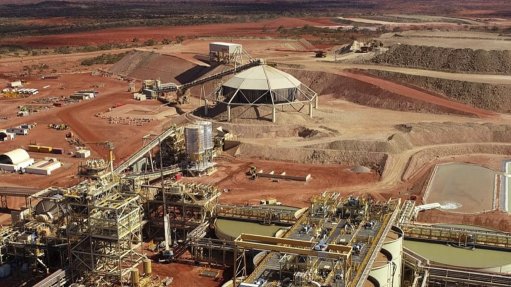Sufficient uranium reserves in Africa to support nuclear programme
Government insists that a decision on the extent of implementation of a nuclear power programme will be made before the end of the current financial year, which runs until March 31, 2014. The Department of Energy (DoE) will, therefore, undertake study tours to several key nuclear-energy jurisdictions, including China, France, Korea and the US, to determine South Africa’s approach should nuclear be confirmed as part of the country’s future energy mix.
The decision to proceed with the proposed nuclear build plan, which aims to add 9 600 MW of nuclear electricity generation capacity to the national grid, is informed by the Integrated Resources Plan 2010 (IRP 2010), which outlines the country’s energy mix for the next 30 years.
The IRP 2010 is informed by the need to diversify the energy mix, a specific emphasis on broadening electricity supply technologies to include gas, biomass and renewable and nuclear energy, in response to the country’s future electricity needs and its commitment to reducing carbon dioxide emissions.
Despite a planned review of the IRP 2010, DoE director-general Nelisiwe Magubane affirmed government’s commitment to nuclear power as part of the country’s future energy mix at the Nuclear Industry Association of South Africa’s 2013 conference in August by emphasising that the reviewed IRP 2010 is unlikely to eliminate nuclear energy from the mix.
“It is a known fact that nuclear power will be the most affordable baseload option after coal,” she said, adding that nuclear was also being considered as a result of the country’s intention to reduce its carbon footprint.
South African Nuclear Energy Corporation CEO Phumzile Tshelane agrees that nuclear power generation is the only noncoal baseload solution for South Africa that can enable the country to meet its carbon emissions targets.
Nuclear will also diversify the energy mix and using local uranium resources will ensure security of fuel supply.
To ensure the success of nuclear energy in South Africa, Energy Minister Dikobe Ben Martins insists that public consultation will be a central feature of any future programme, noting that it is the responsibility of government to reach out to all sectors of society, even those who are against nuclear, to explain the need to use nuclear power.
Tshelane says, according to the IRP 2010, nuclear will account for 13% of the country’s capacity and deliver 18% of dispatchable electricity by 2030, as nuclear generating capacity will comprise 11 400 MW – 9 600 MW of new nuclear power and 1 800 MW from State-owned power utility Eskom’s Koeberg nuclear power station, in the Western Cape.
In light of this, independent mining and minerals management adviser Venmyn Deloitte exploration manager Andrew de Klerk says, should the proposed 9 600 MW of nuclear power be included in the future energy mix, there are sufficient uranium resources in Africa – in Southern Africa in particular – to justify the development of a nuclear programme without having to import uranium from other parts of the world, such as Canada or Australia.
“While there certainly would not be a problem with there being insufficient resources in Africa, whether or not they will be economically viable to mine is another question.”
Further, the knowledge base of Southern Africa’s geology, in terms of the distribution of uranium deposits on the continent, is extremely well understood and explored.
Uranium Resources
Based on this long-standing knowledge and historical and current exploration results, De Klerk believes the bulk of the uranium required to support a nuclear build in South Africa would be sourced from the gold-rich Witwatersrand basin, which stretches from Evander, in Mpumalanga, westward through Gauteng and into the southern and western Free State. The Witwatersrand basin holds significant deposits of uranium, which is largely mined as a by-product to the primary target of gold.
De Klerk says this world-famous geological formation is bound to be the primary source of uranium, as established mining infra- structure is in place to exploit the uranium, in addition to what has already been stockpiled on surface or exists in historical tailings storage facilities.
Further, historical and recent exploration and trial mining results indicate significant uranium resources within the Karoo sediments of the Western Cape, in what has been delineated as the Karoo Uranium province, which extends into the neighbouring Eastern Cape and Free State provinces.
In addition, uranium is present in the ‘Coal Zone’ of the Ecca group, in the Springbok Flats coal field, north of Pretoria.
Other documented uranium deposits of South Africa include deposits within offshore marine phosphate deposits, within the Mozaan Group of KwaZulu-Natal – which are similar to the deposits within the Witwaters-rand – and primary deposits within the Cape Granite and Concordia Granite Suites of the Western and Northern Cape.
Meanwhile, further afield on the continent, uranium exploration is being actively carried out in Mali, Niger and Chad, in West and Central Africa.
Southern Tanzania also hosts significant potential, with exploration being undertaken by Australia-based uranium exploration company Uranex at its Mkuju Uranium Project. In addition, Canadian mining and exploration company Uranium One is developing the neighbouring Mkuju River uranium project.
The Kayelekera uranium mine, in adjacent northern Malawi, owned by uranium producer Paladin Energy, is one of the major producers of uranium in the region exploiting a similar style uranium deposit as being explored for, and developed, in southern Tanzania.
Namibia also hosts well-documented uranium deposits, such as the enriched surficial calcrete uranium deposits. Such deposits are exploited by Paladin Energy at its Langer Heinrich uranium mine, east of Walvis Bay, and at the neighbouring global energy group Areva Resources Namibia’s Trekkopje uranium mine – a mine which stands to become one of the continent’s largest uranium producers.
Namibia also hosts primary uranium deposits in granites, which is mined at diversified mining giant Rio Tinto’s Rössing uranium mine. This is the oldest and one of the largest uranium mines in the world, having started operations in 1976.
The continent’s uranium deposits extend east into Botswana, with significant exploration for uranium being undertaken in paleochannels, gypcretes and calcretes.
Tshelane says the Koeberg nuclear power station and the proposed 9 600 MW comple- ment of new nuclear power will require about 102 000 t of uranium over their combined lifetimes.
Should South Africa require an alternative to uranium, thorium, a rare earths by-product, can be considered as a replacement for uranium in the longer term, if required. Alternatively, uranium and thorium can be used in tandem for future generation reactor types, he notes.
Alternative Fuel
North-West University Nuclear Materials and Thorium research group leader Dr Anthonie Cilliers maintains that using thorium and uranium in tandem in a reactor is a more efficient fuel stock, should the nuclear build programme go ahead, as the nuclear plant can be run for up to 24 months between fuel cycles with the same amount of thorium fuel, as opposed to the 18-month cycles being undertaken at Koeberg.
When considering how thorium can be used in tandem with uranium in a pressurised water reactor – the same reactor technology employed at Koeberg – Cilliers and his research team proposed the replacement of a percentage of the uranium 238 (filler uranium that does not fission) with thorium in the reactor, while maintaining the same amount of uranium 235 (the fuel that runs the plant and fissions) per volume as usual.
“During the 18 months between refuelling schedules, the uranium 238 absorbs neutrons and turns into plutonium – the fuel that sustains the process up to the 18 months.”
Thorium, while working in a similar way, also absorbs neutrons, but instead of turning into plutonium, it turns into uranium 233 – a better breed of fuel.
“It is this ability that enables thorium fuel stock to run the plant for longer on the same amount of fuel,” highlights Cilliers, adding that it is this feature that will ultimately be the driving force behind the adoption of the technology in South Africa.
Reactor Technology and Safety
Koeberg is one of the last Generation II nuclear plants that was built and, since then, Generation III nuclear technology safety precautions have been significantly improved, says Cilliers.
Stress tests have been carried out on the new Generation III plants, subsequent to the Fukushima Dai-ichi nuclear disaster, which was initiated primarily by an earthquake and tsunami on March 11, 2011.
As a result of the nuclear disaster, several passive and fail-safe cooling systems have been incorporated into the reactor that use the laws of nature to prevent a meltdown.
While the earlier-generation nuclear technologies were designed, to an extent, with accident scenarios in mind, the new-generation plants have been tested for beyond-design-based accident scenarios – should something go wrong, the plants are designed to fail in a safe mode, rather than an unknown mode, explains Cilliers.
Meanwhile, the Nuclear Industry Asso- ciation of South Africa (Niasa), the mandate of which is to promote nuclear power generation as part of South Africa’s energy mix, supports the bid by Martins to ensure the future of energy security in South Africa. The association believes that investment in nuclear power goes beyond this mandate and that it will lift South Africa to a new level of human capacity and high technology growth.
Niasa maintains that, although nuclear is more expensive than coal and gas to build, nuclear plants are cheaper to run, with nuclear fuel costs amounting to about 5% of the overall generation costs.
When the decision on nuclear is made, Niasa will commit to working closely with the DoE and government to assist in addressing any concerns the public may have about nuclear technology.
Comments
Press Office
Announcements
What's On
Subscribe to improve your user experience...
Option 1 (equivalent of R125 a month):
Receive a weekly copy of Creamer Media's Engineering News & Mining Weekly magazine
(print copy for those in South Africa and e-magazine for those outside of South Africa)
Receive daily email newsletters
Access to full search results
Access archive of magazine back copies
Access to Projects in Progress
Access to ONE Research Report of your choice in PDF format
Option 2 (equivalent of R375 a month):
All benefits from Option 1
PLUS
Access to Creamer Media's Research Channel Africa for ALL Research Reports, in PDF format, on various industrial and mining sectors
including Electricity; Water; Energy Transition; Hydrogen; Roads, Rail and Ports; Coal; Gold; Platinum; Battery Metals; etc.
Already a subscriber?
Forgotten your password?
Receive weekly copy of Creamer Media's Engineering News & Mining Weekly magazine (print copy for those in South Africa and e-magazine for those outside of South Africa)
➕
Recieve daily email newsletters
➕
Access to full search results
➕
Access archive of magazine back copies
➕
Access to Projects in Progress
➕
Access to ONE Research Report of your choice in PDF format
RESEARCH CHANNEL AFRICA
R4500 (equivalent of R375 a month)
SUBSCRIBEAll benefits from Option 1
➕
Access to Creamer Media's Research Channel Africa for ALL Research Reports on various industrial and mining sectors, in PDF format, including on:
Electricity
➕
Water
➕
Energy Transition
➕
Hydrogen
➕
Roads, Rail and Ports
➕
Coal
➕
Gold
➕
Platinum
➕
Battery Metals
➕
etc.
Receive all benefits from Option 1 or Option 2 delivered to numerous people at your company
➕
Multiple User names and Passwords for simultaneous log-ins
➕
Intranet integration access to all in your organisation


















